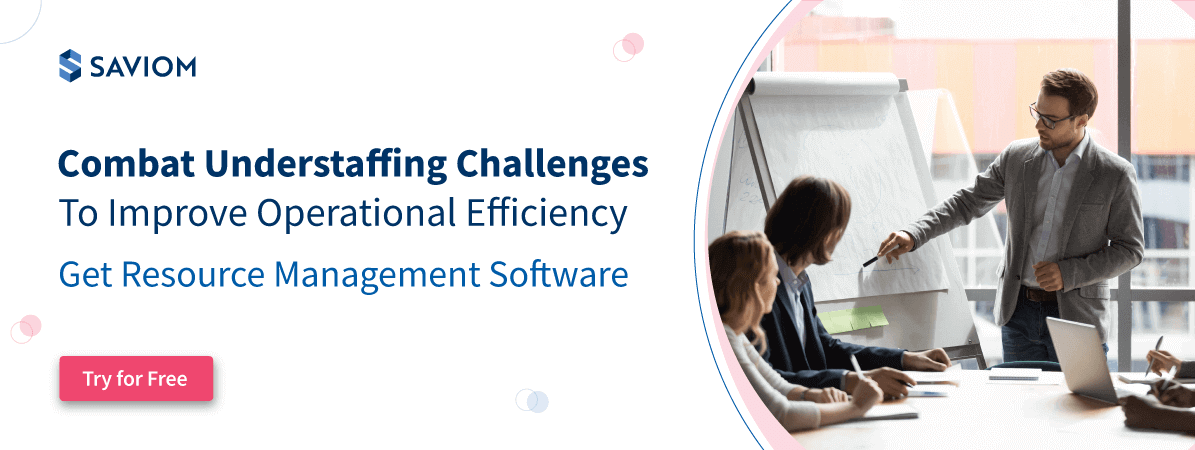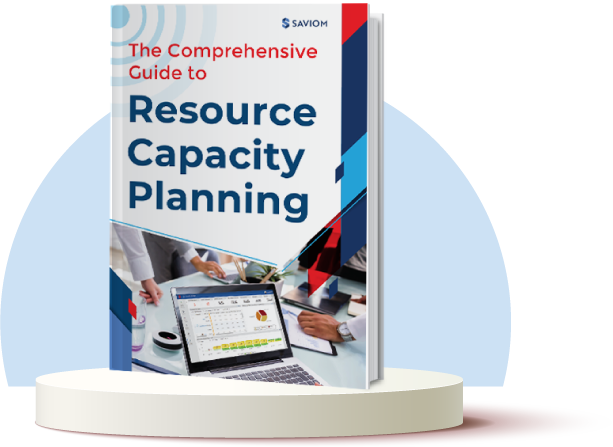According to the U.S. Bureau of labor statistics, a record-breaking 4.5 million employees quit their jobs, and another 1.4 million were discharged or relieved as of March 2022.
This exponential increase in planned and unplanned attrition is attributed to the global COVID-19 outbreak. Due to the economic upheaval, several organizations had to cut costs, relieve non-critical employees, and operate on limited resources. Moreover, the increased global competition for niche talent and growing skills shortage has also left many organizations understaffed. Understaffing can have severe repercussions on businesses. From employees being stressed and burnt out to compromised work quality and revenue loss due to lost opportunities, it negatively impacts a company’s overall efficiency. However, if appropriately managed, business leaders can enhance operational efficiency even when understaffed. This article explains the impact of understaffing and how one can combat it with a definite strategy. Let’s delve into the basics, 

What is operational efficiency, and how does understaffing impact it?
Operational efficiency is the ability of an organization to deliver high-quality projects and services/products with limited resources. It can be measured by comparing an organization’s revenue generated against expenses incurred for every project. Operational efficiency factors in several metrics like production capacity, labor productivity, turnaround time, and profitability. If an organization is understaffed, it may witness a decline in these metrics. Organizations might overutilize their existing resources to keep that occurrence at bay by allocating extra work to meet the project requirements. However, the downside is that employees feel stressed and burned out when given an unmanageable workload or allocated beyond their capacity. This can result in unplanned absenteeism and even high employee turnover. In addition, they may miss deadlines, and work quality inevitably suffers. When businesses cannot deliver high-quality projects within the stipulated time and budget, customer dissatisfaction jeopardizes the brand’s reputation. All of this may further lead to lost growth opportunities and question the firm’s sustainability. The pertinent question is, can organizations function efficiently and negate this impact, even when they don’t have enough workforce? The answer is a resounding yes. Let’s see how. 

11 Ways to manage understaffing and boost operational efficiency
Since understaffing is a consistent issue in organizations today, managers can adopt ways to make the best use of their existing resources and enhance operational efficiency. The following ways will help you in the process.
Prioritize projects based on business value and strategic goals
When organizations are functioning with fewer resources, it’s imperative to ensure that only profitable and value-adding projects are undertaken. Otherwise, they will end up utilizing the workforce without any substantial ROI. Therefore, managers can coordinate with the PMO to help identify profitable and strategically aligned projects. This way, they can deploy their talent pool on the right projects, contributing to the organization’s growth. In addition, working on such projects ensures that the financial and long-term goals are met even with a limited workforce, thereby increasing operational efficiency.
Ensure effective time and task management
Adequate time and task management are key to boosting operational efficiency, especially when you are understaffed. Thus, the onus lies with managers to ensure every project task is defined clearly and given a realistic timeline. Because you are facing resource constraints, giving unrealistic deadlines will cause more harm than good. Moreover, employees can plan ahead of the curve and avoid any potential delays when working with a well-defined schedule. So, managers can implement the work breakdown structure that helps divide the projects into smaller, manageable tasks and estimate the deadline for each. Once the required skillset is defined, they can allocate competent resources for the job and clarify the roles and responsibilities. This will ensure timely delivery and ensure no task is overlooked or missed.
Read More: Time Management: How It Is Important for Project Delivery
Track project financials regularly to avoid loss of revenue
Profitability is one of the very important metrics to assess operational efficiency. Naturally, higher profitability implies better efficiency. Thus, managers must track project financials regularly. If not, it can lead to budget overruns, billable loss, and more. The pertinent question is, how can they procure accurate data? Implementing a project and resource management tool will provide real-time insights into project costs forecast vs. actuals where managers can evaluate variances between planned and actual costs, etc. This helps them take corrective actions well ahead of the curve and avoid any loss of revenue. Moreover, while estimating the budget during the planning stage, managers should leverage lesson-learned reports to improve accuracy.
Implement resourcing treatments to optimize the workforce
Project managers are in a predicament when they have to deliver projects with less resources as multiple risks are involved. For instance, the absence of a critical resource can hamper other dependent tasks, derailing the whole project. In this case, implementing the right resourcing strategy such as out-rotation and backfill can help save both the ongoing and the new project. Moreover, when you are understaffed, optimizing and building a future-ready workforce is of utmost importance. This ascertains that each employee is equipped with appropriate competencies to manage evolving demands. So, organizations can conduct upskilling and training programs to achieve this. These practices enable managers to deliver quality projects with limited availability of resources.
Read More: How can you Implement Workforce Optimization to Improve Productivity?
Hire contingent workforce to fulfill short-term niche requirements
Often projects demand niche-skilled resources that are not available within the organization’s talent pool. If this is a one-time requirement, they can hire contingent workers such as freelancers or contractors from empaneled vendors to get the job done. This way, organizations can avoid unnecessary overheads of hiring permanent employees or losing the opportunity altogether. To gauge if the demand is one-time or recurring, managers can deploy a resource management tool that provides a bird’s eye view of current and pipeline project demand. This will also reduce training time, minimize unnecessary hiring/firing cycles, help form the right mix of permanent and contingent staff, and elevate overall efficiency.
Ensure profitable resource utilization for better productivity
Resources are the most significant investment and success drivers of any organization. Thus, managers are responsible for tapping into the maximum potential of every employee and ensuring optimal utilization. For instance, if a resource is underutilized or spending more time on BAU or admin tasks, they are not generating substantial revenue, which declines profitability. Thus, managers must correct and mobilize or reallocate them to billable or strategic projects. This will boost productivity and ascertain revenue generation, eventually enhancing efficiency.
Read More: Maximize Profitable Resource Utilization with Modern Resource Management Solution
Encourage cross-departmental collaboration
Organizations must ensure that they have an adequate talent pool to avoid missing out on opportunities or new projects. The first question that surfaces is, how can one achieve this when there is a resource crunch? Cross-departmental collaboration is the solution to combat this. It allows employees to work on projects that do not fall under their respective departments but demand their skills. This will facilitate sharing of resources and also let employees diversify their portfolios. This way, businesses can intelligently utilize their existing workforce, deliver projects successfully, and improve efficiency.
Automate and streamline administrative work
As discussed earlier, when employees spend more time on BAU work, it affects their productivity and the organization’s profitability. To prevent this, businesses should implement the right tool inventory that can automate mundane tasks. For instance, they can streamline repetitive tasks like generating reports, invoicing, and billing using automation tools and software. Thus, employees can utilize their time on human-critical activities such as strategic work, tasks, etc. In a nutshell, automation will help you put your limited resource pool to the best use and add to the efficiency.
Invest in multi-skill building programs and IDPs
One of the many most effective ways to improve efficiency while understaffed is conducting multi-skill building programs and IDPs. Many employees are generalists, meaning they are proficient in performing different tasks that demand varied competencies. Organizations can leverage these resources and hone their skills to allocate them to diverse projects. Thus, even if you have a smaller resource pool, you will not miss out on new opportunities and can deploy the employees on multi-faceted projects and upkeep efficiency. Furthermore, it ensures optimal utilization and increased productivity, boosting operational efficiency.
Read More: How Can Retraining/Upskilling Future-Proof Your Workforce?
Conduct regular rewards and recognition programs
When there is a resource shortage, the existing workforce puts in their maximum effort and goes the extra mile to ensure quality project delivery. Thus, they expect to get rewarded and compensated for their hard work. Without that, employees may feel disengaged and demotivated at work. Hence, organizations can formulate employee recognition programs that acknowledge the contribution and high performance. They can leverage their company’s social media handle and give shout-outs to their employees or offer physical fitness programs or mental well-being sessions. This will foster a sense of belonging and make employees feel valued and appreciated at their workplace. Eventually, it increases their drive for work resulting in higher efficiency.
Read More: Employee Recognition Programs: Types, Benefits and Best Practices
Build assets within the project and reuse them as appropriate
Organizational assets include tech inventory, machinery, human resources, lesson learned reports, knowledge base, etc. These assets demand high investment and hold high value. Thus, to get the maximum output of their investment, one can reuse such assets for similar projects or endeavors. For instance, a project requires a code to automate some tasks. Once the employee develops this code, organizations can preserve it in their repository and make it available for others to use as and when there is a need. This will save time and money spent on doing the same task, allow employees to complete other tasks at the same time, and ensure efficiency. Coupled with the above-mentioned strategic tips, organizations can implement modern resource management software to mitigate the challenges of understaffing. The following section explains ways this software helps in elevating operational efficiency,
How can resource management help manage understaffing and enhance operational efficiency?
Advanced resource management software can help in dealing with understaffing and maximize operational efficiency in the following ways:
- It provides visibility of pipeline project demand and offers real-time insights into the capacity vs. demand gap, thus helping you make informed decisions ahead of the curve to bridge the gap.
- The tool provides a centralized view of the enterprise-wide resource pool, thus facilitating competent resource allocation based on the project demand. Moreover, it allows managers to utilize employees across matrix boundaries.
- The Business Intelligence tool provides accurate information on forecasts versus actuals (utilization, financials, etc.). Thus, managers can evaluate if resources are taking more time to complete a task than estimated or if there is any budget overrun and take corrective course measures to secure the project’s fate.
- Visibility into the present and future resource schedules and utilization heatmap allows managers to see if resources are working on billable or non-billable projects and if they are over or underutilized. Accordingly, they can either ease their workload, assign additional work (if underutilized), or mobilize resources from non-billable work to billable and strategic work.
Read More: Top Ten Business Benefits of Resource Management
All these benefits ensure that organizations are effectively utilizing their workforce, which directly leads to better operational efficiency.
Conclusion
Operational efficiency is incumbent to stay sustainable and profitable in the hyper-competitive market. Therefore, even though you are understaffed, it is imperative to take the right measures and stay afloat to stay relevant. The above-mentioned strategies will not just keep you afloat but will enable you to maintain your competitive edge. Moreover, paired with the right software will take your productivity and efficiency to the next level.
The Glossary
Read More: Glossary of Resource Workforce Planning, Scheduling and Management
The SAVIOM Solution
SAVIOM is the market leader in offering the most powerful and configurable solutions for managing enterprise resources efficiently and effectively. Having more than 20 years of experience, this Australian-based MNC has a global presence in over 50 countries. It is also popular with more than 100 customers and helps them achieve their business goals. SAVIOM also has products for project portfolio management, professional service automation, and workforce planning software which can be easily customized as per business requirements.








